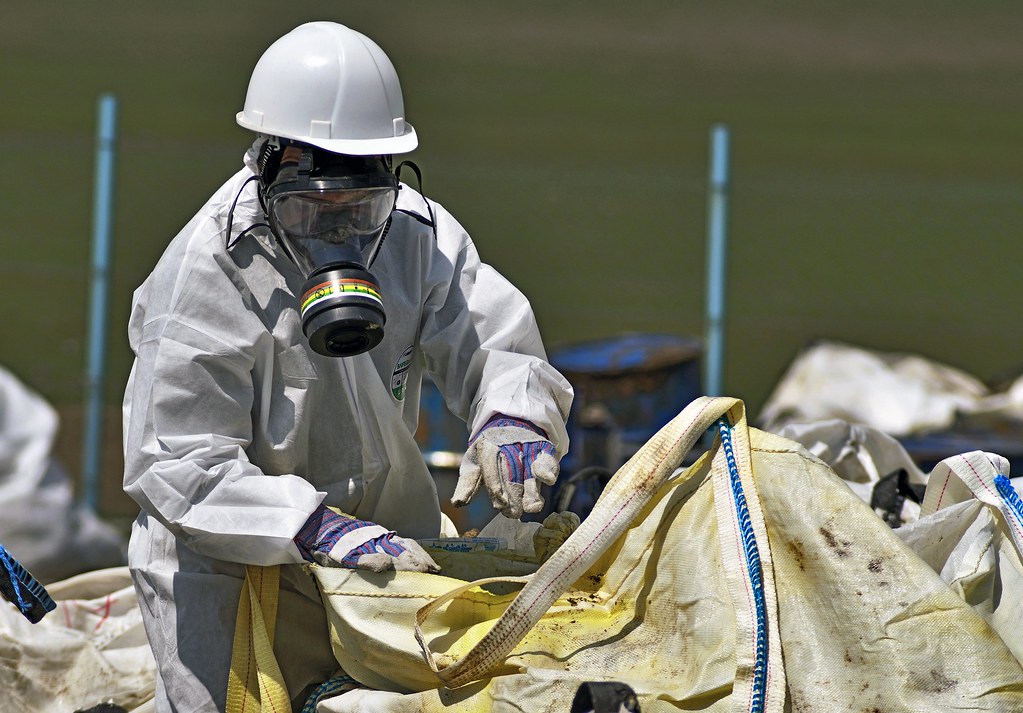Remediation Efforts at the Johns-Manville Superfund Site May Increase Asbestos Exposure
By: Caitlin Federici
Cleanup methods implemented at the Johns-Manville superfund site may be inadvertently increasing asbestos exposure to surrounding communities. The EPA has designated the old Johns-Manville asbestos manufacturing facility in Waukegan, IL, as a Superfund site on the EPA’s National Priority List.[1] The EPA characterizes Superfund locations as “contaminated sites [where] hazardous waste [was] dumped, left out in the open, or otherwise improperly managed.”[2] Such sites require specialized cleanup, containment, and long-term monitoring to prevent or reduce public and environmental exposure to contamination.[3]
The Johns-Manville site was once the world’s largest asbestos manufacturing facility.[4] It is situated on the shore of Lake Michigan with the Illinois State Beach Park immediately north of the site’s fence line and five more hazardous waste sites on its southern edge.[5] The site spans 350 acres with the asbestos waste disposal area taking up about 150 acres.[6] It is estimated that about 3 million cubic yards of contaminated material was disposed of in the waste disposal area, alone.[7]
Past Cleanup: Capping
In 1998 Johns-Manville agreed to study the extent of asbestos contamination after the EPA urged the corporation to do so. Following the study, EPA began an extensive site cleanup in 2000 and completed the planned remediation by 2018. This consisted primarily of demolishing the buildings, consolidating the toxic waste, and then capping the entire site.[8] Capping is a remedial technique that involves covering the contaminated material rather than removing the toxic waste from the site.[9] If the site is suitable for post-remediation development, asphalt or concrete can be used as the cap and parking lots or buildings are then constructed over the cap.[10] If the site will not or cannot be developed, often due to significant levels of contamination, the site is capped with layers of clay, soil, and vegetation; in some instances, a layer of synthetic material such as geomembrane is installed to further protect the contaminated material.[11]
The EPA frequently uses capping to address asbestos-contaminated Superfund sites. Asbestos fibers have a hair-like shape leading scientists to believe that the mineral could not easily travel through soil.[12] However, a recent study published in 2021 by Stanford professor, Jane Willenbring, suggests this assumption is dangerously inaccurate.[13]
New Research Raises Concerns
Willenbring’s research appears to show that “dissolved organic matter changes the electric charge on asbestos particles [making] them less sticky” which ultimately allows the fibers to move faster through soil.[14] This means that capping asbestos sites with organic matter such as soil and vegetation—which is what the EPA used at the Johns-Manville site—may actually increase the risk of further contamination rather than isolate the hazardous material.[15]
The results of this study appear to align with the results of follow-up sampling of areas surrounding the site. Seven areas of asbestos contamination have been discovered outside the site’s fence line despite the EPA’s efforts to contain the asbestos waste within the boundaries of the Superfund site.[16]
Asbestos exposure can lead to lung disease and cancer, including a rare and aggressive form called mesothelioma.[17] Mesothelioma is almost always fatal; the average life expectancy once diagnosed is 4-18 months.[18] Although asbestos is generally considered dangerous as an air pollutant, it can pose a risk to public health if it contaminates groundwater because it can become airborne again when the contaminated water evaporates.[19] This is of particular concern where such contaminated water is used in humidifiers or during showers because the water vapor is highly concentrated.[20]
Conclusion
There are no long-term studies that assess how significant or far-reaching the threat of asbestos-laced soils could be for public health or the environment. Willenbring’s research is still in its preliminary stage, but she notes that with thousands of asbestos waste sites around the country, millions of Americans may be in danger.[21] Thus, the EPA should take these findings very seriously and assess whether alternative remedial approaches such as waste removal or containment within cement cannisters are more appropriate for asbestos sites than organic and vegetative capping.
[1] Env’t Prot. Agency, Johns-Manville Corp. Waukegan, IL, Cleanup Activities, (last visited Dec. 25, 2022), https://cumulis.epa.gov/supercpad/SiteProfiles/index.cfm?fuseaction=second.Cleanup&id=0500197#Limits; Michael Hawthorne, Johns Manville to clean lagoons, Chicago Tribune (Feb. 15, 2004), https://www.chicagotribune.com/news/ct-xpm-2004-02-15-0402150048-story.html
[2] Env’t Prot. Agency, What is Superfund?, (last visited Dec. 25, 2022), https://www.epa.gov/superfund/what-superfund
[3] Id.
[4] Env’t Law & Policy Ctr, Rising Waters, 10 (2022), https://elpc.org/wp-content/uploads/2022/08/ELPCRisingWatersReport_2022.pdf
[5] Id.
[6] Env’t Prot. Agency, supra note 1.
[7] Id.
[8] Env’t Prot. Agency, A Citizen’s Guide to Capping, (Sep. 2012), https://www.epa.gov/sites/default/files/2015-04/documents/a_citizens_guide_to_capping.pdf
[9] Id.
[10] Id.
[11] Id.
[12] Danielle Torrent Tucker, U.S. asbestos sites made risky by some remediation strategies, according to Stanford researcher, Stanford News (April 23, 2021), https://news.stanford.edu/2021/04/23/u-s-asbestos-sites-made-risky-remediation-strategies/; Env’t Law & Policy Ctr, supra note 4.
[13] Tucker, supra note 12.
[14] Tucker, supra note 12.
[15] Id.
[16] Env’t Prot. Agency, supra note 1.
[17] Env’t Law & Policy Ctr, supra note 4.
[18] Abramson Cancer Center, Prognosis, Penn Medicine (last visited Dec. 25 2022), https://www.pennmedicine.org/cancer/types-of-cancer/mesothelioma/prognosis#:~:text=Mesothelioma%20Survival%20Rate%20%E2%80%93%20The%20mesothelioma,disease%20is%20just%2010%20percent.
[19] Env’t Law & Policy Ctr, supra note 4.
[20] Tucker, supra note 12.
[21] Tucker, supra note 12.


